- Home
- Encyclopedia
- Wyoming To The White House: Dick Cheney’s Life ...
Wyoming to the White House: Dick Cheney’s Life in Politics
Donald Rumsfeld looked skeptically across his White House desk at the graduate student and congressional fellow from Wyoming. It was 1969, and Rumsfeld was the newly appointed head of the Office of Economic Opportunity, and a close adviser to President Richard Nixon.
When Rumsfeld was a congressman from Illinois, he had flatly rejected this fellow when he came looking for a legislative aide job. The young man instead took a post with a Wisconsin congressman, and then, unsolicited, wrote Rumsfeld a memo advising him how to handle his congressional confirmation hearing as head of the OEO. That got Rumsfeld’s attention, and this time he offered Dick Cheney a job—or, rather, gruffly informed him during a brief office visit: “You’re congressional relations—now get out of here.”
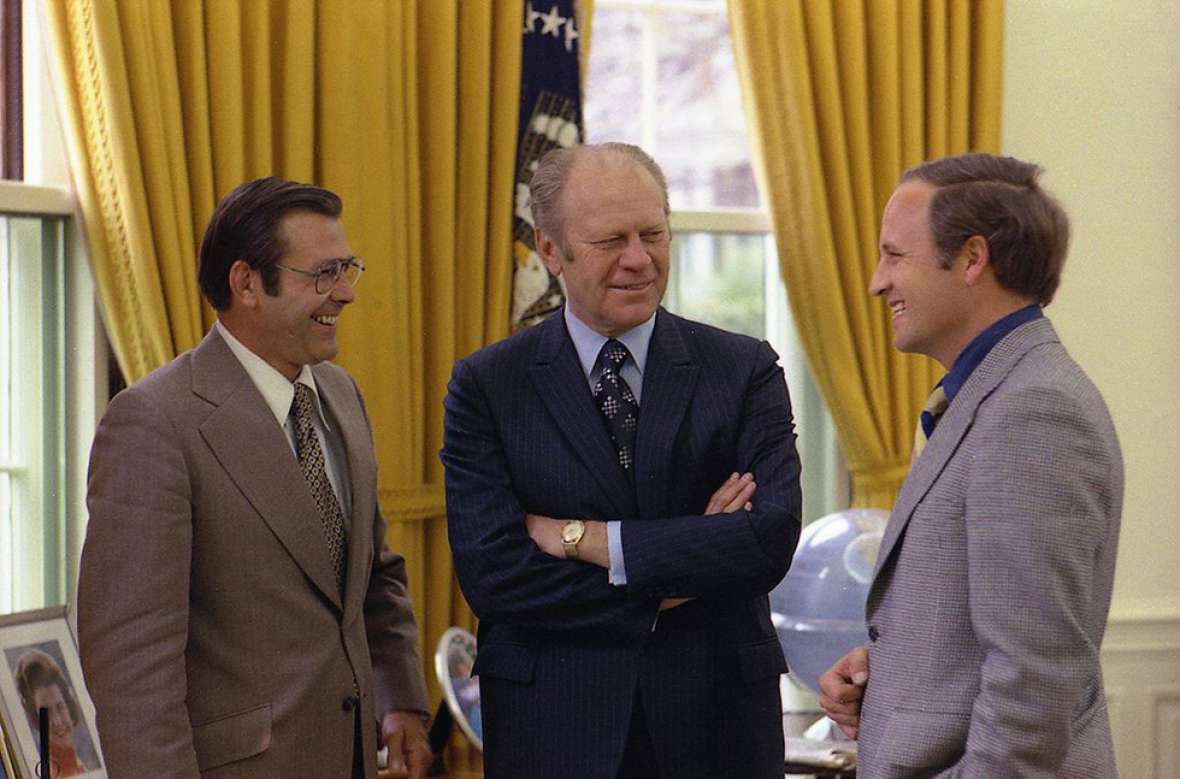
A White House pass requires a full field investigation by the FBI, and it unearthed some things not often found on a top aide’s resumé. So Dick Cheney, a young man not yet 30, stood before Rumsfeld again: The investigation found that he had been kicked out of Yale before academically rehabbing himself at the University of Wyoming, after some thinking time in a Rock Springs jail cell for drunken driving.
“What about this?” asked Rumsfeld.
“Yes, it’s true,” answered Dick Cheney.
“Did you put it in your employment form?”
“Yes sir, I did.”
“Okay,” said Rumsfeld, “that’s good enough for me.”
That was the beginning—as Humphrey Bogart once said to Claude Raines in wartime Casablanca—“of a beautiful friendship.” And Dick Cheney—from the unlikely provenance of Wyoming—was on his way to becoming one of the most powerful men in the world.
Rocky starts
Richard Bruce Cheney was born in Lincoln, Neb., on Jan. 30, 1941, the day Franklin Delano Roosevelt turned 59, and his parents, both of whose families had been Democrats since the Civil War, sent the President a proud telegram.
Cheney’s father moved the family farther west when the U.S. Soil Conservation Service shuffled its offices and offered him a job in either Wyoming or Montana. At 13, Dick Cheney was living on the east side of Casper, with prairie for a backyard, and playing Pony League baseball, where he found lifelong friends like Tom Fake. His father, also Richard Cheney, would be a lifelong civil service employee (and Democrat); “utterly stable” according to his son, who felt that explained his own penchant for taking risks.
That risk-taking may not have been so evident in Casper, where Cheney was a soft-spoken, football-playing high schooler who fished with his buddies and earned pin money at the Ben Franklin store. His boldest move at the time may have been dating Lynn Vincent, a top student and star baton twirler. “I didn’t have a political identity one way or the other,” he remembered, though he was elected senior class president.
A local oil man who’d gone to Yale, Tom Stroock, had the leverage to get a few promising kids into his alma mater, and Dick Cheney was one of them. Being from Wyoming, it was “affirmative action,” he would later joke. It did not go well. The school cut his scholarship in the second year, and it still did not go well. Finally, the dean suggested he take a year off. He did so—putting up transmission line in Wyoming. There was a third try at Yale, and then back to being a lineman. Cheney was much more comfortable working outdoors in Wyoming than he was in the Ivy League, and his $3.10 an hour as a lineman bought him plenty of beer. The beer got him his second DUI and jail time in Rock Springs in 1963. It was there that he realized “if I continued on that road I was going to come to a bad end.”
Sobered up, and newly married to Lynn Vincent (who was headed to graduate school), he was a better student at the community college in Casper and the University of Wyoming in Laramie than he had been at Yale. He did an internship at the Wyoming Legislature—and discovered he was a Republican—before joining his wife in graduate school at the University of Wisconsin. His trajectory was toward a doctorate in political science and a university teaching career.
Washington insider
But Cheney had the bug: He wanted to be in politics and government. He got a fellowship to work in a congressional office in Washington, D.C., but not initially with the young congressman he admired from Illinois, Donald Rumsfeld, who gruffly told him after a job interview, “Thank you very much, this isn’t going to work,” remembered Cheney. “Boom, I was out.”
That rejection was the beginning of a relationship between the two that would endure their entire careers—with each of them, at one time or another, seriously seeking the presidency. Rumsfeld was the more obvious political star—a Princeton grad, a congressman, a young Nixon adviser unstained by Watergate, then multiple important positions under President Gerald Ford. It was during Rumsfeld’s first stint in the executive branch, under Nixon, that he signed up Cheney as his chief lieutenant. This incongruously put two conservative Republicans in charge first of an anti-poverty program originated during President Lyndon Johnson’s Great Society (the OEO), and then managing Nixon’s controversial big-government wage and price controls on the Cost of Living Council. After Nixon’s resignation, Rumsfeld became chief of staff to President Gerald Ford, the former congressman and appointed vice president who had succeeded Nixon; when Rumsfeld became the youngest secretary of defense in history in 1975, his even younger assistant was poised to succeed him as White House chief of staff, at only 34 years old.
For Cheney, returning to graduate school looked pretty dull.
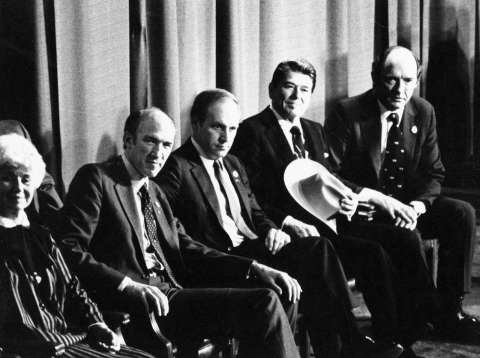
It was as Gerald Ford’s chief of staff that Cheney’s talent for behind-the-scenes executive and political management blossomed. By controlling the president’s schedule and access, he made himself invaluable to the executive and unavoidable to those who sought the chief’s ear. His soft-spoken, unaffected style was in marked contrast to the recent memory of H.R. Haldeman and the rest of Nixon’s thuggish crew. “An excellent chief of staff,” Ford told the Washington Post in 2006. “First class.”
Eight-term congressman
After Ford was narrowly defeated by Jimmy Carter in 1976, Cheney returned to Wyoming—his credentials somewhat burnished since his lineman days—and in 1978 ran for the state’s sole seat in the U.S. House of Representatives, an open seat at this point with the retirement of Democrat Teno Roncalio. Despite a heart attack in the midst of the campaign—a legacy of his family genes and his White House diet of cigarettes, donuts and coffee—Cheney would be re-elected to the office five times.
Early on, he made frequent trips back home—170 days in his first two-year term, to “nail down my base in Wyoming, because I wanted to get involved in long-term and difficult and controversial issues.” He and the close-knit Wyoming delegation—Sens. Alan Simpson and Malcolm Wallop—did pass a landmark Wyoming wilderness bill that protected 880,000 acres of public land in 1984.
But generally, Cheney was free to pursue difficult issues of his own choosing, often remote from Wyoming. He served on the House Intelligence Committee, privy to top-secret programs operating around the globe. His colleagues quickly identified him as a smart, hardworking legislator, fair-minded enough for duty on the House Ethics Committee during the years of the Abscam scandal—a bribery sting that netted several congressmen—and on the committee investigating the Iran-Contra scandal, when secret arms sales to Iran were used by the Reagan administration to finance Nicaraguan rebels.
As long as the feds are kept at bay, Cowboy State voters don’t pay that much attention to their D.C. delegation, it seems. “I once traveled 300 miles to attend a two-person coffee,” Cheney wrote in his memoir. “And one of the two people was my local chairman.” Yet after his first race, he would win more than 60 percent of the Wyoming vote each time he ran.
By 1988, Cheney was House minority whip and clearly in line to be speaker of the House if Republicans re-took the chamber, ahead of competitors like Trent Lott and Newt Gingrich. Instead, his career would take an improbable turn: when the nomination of Sen. John Tower (R-Tex.) as secretary of defense was blocked by the Senate, President George H.W. Bush turned to the Wyoming congressman.
Secretary of defense
Cheney was in some ways an improbable secretary of defense. He himself had never served in the military—during his years of draft eligibility, during the Vietnam War, he received education deferments and, when those expired, he and Lynn had their first child, another exemption. He was also, in 1988, a man with a bad heart, which had led to six hospitalizations over the previous decade, and quadruple bypass surgery the summer before his nomination.
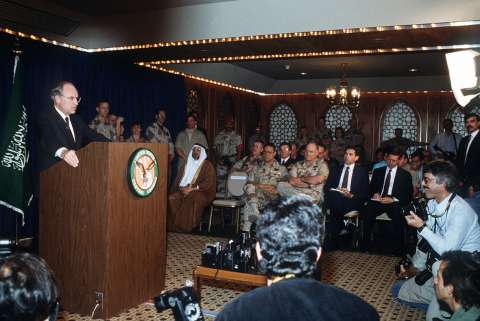
But he unhesitatingly asserted his authority at Defense—even firing a member of the Joint Chiefs of Staff, Air Force Gen. Michael Dugan—and gained respect inside and out of the Pentagon for his handling of military interventions in Panama and the Middle East.
Desert Storm, in 1991, in which an international coalition led by American troops drove Iraqi invaders out of Kuwait, is widely credited with restoring the USA’s confidence in its military might, erasing doubts growing out of the miasma of the Vietnam War. With Gen. Norman Schwarzkopf in command, and Gen. Colin Powell as the Cheney-picked chairman of the Joint Chiefs of Staff, it was a swift, carefully crafted action. Iraqi resistance melted so quickly that a cease-fire was declared only 100 hours after the U.S. ground troops crossed into Kuwait to drive out the Iraqis.
If anything, Cheney was faulted for his restraint, bringing the troops home rather than pursuing the defeated Saddam Hussein to Baghdad. “Look, we did what we set out to do,” Cheney said later. “The Saudis and others hadn’t signed on for us to go running through the Middle East toppling dictators.”
Fate had picked an interesting time for Cheney to be atop the Department of Defense. With the Soviet Union breaking up and the Cold War ending, he presided over a major reduction in Defense spending, even torpedoing some weapons programs with powerful congressional sponsors, such as the Navy A-12 fighter jet. He also played a role in negotiating a new Strategic Arms Reduction Treaty to reduce nuclear weapons aimed between the superpowers.
When he left Defense in 1993, Cheney’s reputation for smart decision-making, lack of vanity and calm leadership had never been greater. There were White House conversations—Cheney was not in on them—about his replacing Dan Quayle as George H.W. Bush’s running mate for a second term.
Halliburton
After Bush lost in 1994 to Bill Clinton, Cheney explored running for president himself. He traveled around the country speaking for Republican candidates and formed a political action committee. He elected not to run, though, after polls indicated he was not gaining traction with voters; he would later say that the decision was compelled by his dislike for fundraising and possible public concern about his health.
At 53, though, Cheney’s bypassed heart was working fine. He was ready to try something new, and he felt “my future from a private sector standpoint was unlimited.”
As his public profile grew, Cheney often sought opportunities to indulge his private passions: fishing and hunting. Those trips were often to remote locations with corporate bigwigs; it was on one such trip, salmon fishing in New Brunswick, that the retiring CEO of the Halliburton Company, an international oilfield services company based in Texas, became interested in Cheney. Thomas Cruikshank, the retiring CEO, felt Cheney’s government experience and foreign affairs knowledge would help with the company’s expanding “international dealings,” and made up for his lack of corporate experience.
Halliburton and Cheney were not strangers. When Cheney was at Defense, the department hired Halliburton to study “privatizing” support services for the military at war. Halliburton then got a five-year contract to do the job.
Cheney doesn’t highlight his five years at Halliburton on his resumé, but the corporate world gave him moderately positive reviews, with the caveat—several Texans say—that on a personal level he was a little reserved for the Dallas country club set. His biggest move was the 1998 acquisition of Dresser Industries for $7.7 billion, which appeared to be a good fit, but later saddled the company with a heavy load of asbestos liability lawsuits.
Vice presidential candidate
Half a decade into Cheney’s tenure at Halliburton, another Texas businessman-politician was making a run for the White House, and George W. Bush needed help vetting prospects for the second spot on his ticket. The Halliburton CEO, ostensibly not interested in the job himself, put candidates through a gauntlet of unprecedented questions and demands for medical records and documentation.
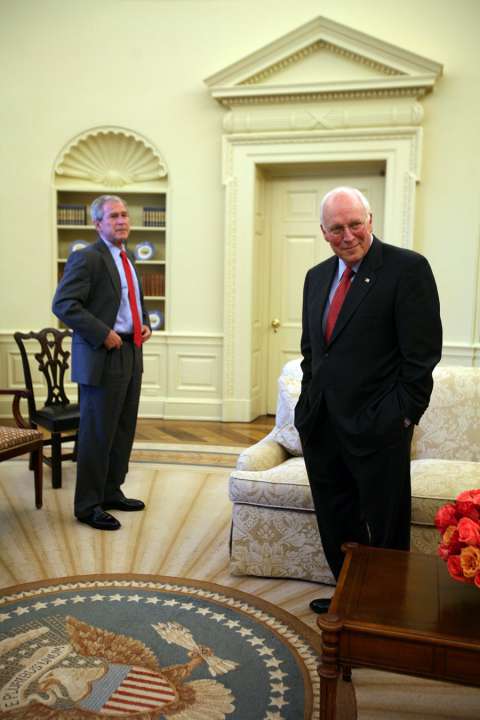
When the choice ended up being Cheney himself—with a less strenuous vetting process than the candidates before him—there were snickers and editorial cartoons. But Bush insisted he wanted Cheney all along, impressed by his experience, his suitability to be president, and his “practical mind and dry sense of humor.” Finally, he pestered a reluctant Cheney into taking the challenge.
Cheney, with his lack of charisma, his health concerns and his reputed dislike for campaigning didn’t appear to offer much to the ticket except, as he joked at the Republican convention, the three Electoral College votes of firmly Republican Wyoming.
But Bush wanted his experience, his foreign policy expertise and his even-tempered, thorough administrative style. In the actual campaign, Cheney enthusiastically followed the expected script for a V.P. candidate, sinking “attack dog” teeth into outgoing President Bill Clinton and Bush’s opponent, Al Gore. He also delivered a smart, gentlemanly debate with Democratic V.P. candidate Sen. Joe Lieberman (D-Conn.) that Time called “a cleanser of the political palate.”
The vice presidency
If Cheney was a somewhat reluctant candidate, he went at the job of vice president with unprecedented assertiveness, despite suffering his fourth heart attack during the Florida recount. He placed longtime allies in key executive posts, lunched privately every week with the president, managed a secretive task force to draft a fossil-fuel-friendly energy policy and held carte blanche to attend any cabinet meetings he chose.
But Cheney’s vice presidency—and the George W. Bush presidency—would be defined by the field he considered his forte: national security. When al-Qaeda terrorists crashed hijacked passenger jets into the World Trade Center and the Pentagon, the Secret Service grabbed Cheney by the belt, hustled him down to the White House bunker and the die was cast.
From that moment forward, he would be fully engaged in the national security issues that had preoccupied him since his days on the 1970s House Intelligence Committee. As Cheney told Tim Russert on Meet the Press five days after the attack, the U.S. now had to work “the dark side.” In the years to follow, that would include pre-emptive military action, sweeping international and domestic surveillance and rough treatment for enemy prisoners.
Though Afghanistan, which provided al-Qaeda its operating base, was the initial military target of the U.S. after 9/11, Cheney and Defense Secretary Donald Rumsfeld early on advocated attacking Iraq, citing links to the 9/11 terrorists and reports that Saddam Hussein was stockpiling weapons of mass destruction. This time—despite a plea to the United Nations by Secretary of State Colin Powell—there was no international coalition like the one that fought and paid for Desert Storm in 1990-1991. The United States essentially had to go it alone.
U.S. troops easily routed the Iraqis, but no WMDs were found; Saddam Hussein was removed and eventually executed, but the U.S.-backed Iraqi government faced an insurgency that dragged into President George W. Bush’s second term. With the events of 9/11 fading in public memory, Bush’s approval ratings fell dramatically, and critics characterized Cheney—with his penchant for secrecy and unbowed hawkishness on the terrorism front—as “Darth Vader.”
Bush, less dependent on Cheney in his second term, turned more and more to Secretary of State Condoleezza Rice and others for national security advice. In 2005, when the Syrians began building a nuclear facility with North Korean assistance, Cheney proposed bombing the facility; Bush asked a roomful of advisers for a show of hands and only the vice president’s was raised. When Cheney aide “Scooter” Libby was convicted of perjury in 2007, Cheney’s personal pleading for a presidential pardon fell on deaf ears.
While he was still in office, some former allies contended the Cheney who returned to Washington as vice president was not the same man they knew when he ran the Pentagon in the early 1990s. Brent Scowcroft, who headed the National Security Administration under President George H.W. Bush and worked closely with Defense Secretary Cheney, said in The New Yorker in 2005: “I consider Cheney a good friend—I’ve known him for 30 years. But Dick Cheney I don’t know anymore.”
Yet Cheney, who says he never lost sleep over the tough decisions he made while in power, sees it differently. “I didn’t change,” he told the Wall Street Journal in 2011. “The world changed.”
After leaving office in 2009, Cheney’s health declined rapidly. He depended on a Left Ventricle Assist Device (LVAD) to do the work of his failing heart, until, in 2010, he received a heart transplant.
The nine-hour operation to implant the donated heart was successful. In the years since, Cheney has resumed an active life. He hunts and fishes avidly, writes, and spends time in his Jackson, Wyo., and McLean, Va., homes with his wife and grandchildren. “It’s just a remarkable thing,” he said in 2013, “to suddenly get a new gift of time. It’s like being reborn.”
Resources
Primary sources
- Baker, Peter. Days of Fire: Bush and Cheney in the White House. New York: Doubleday, 2013.
- Baker, Peter. Interview, Geoff O’Gara, May 30, 2014.
- Bush, George H.W., Presidential Papers, Texas A&M University, College Station, Texas.
- Bush, George W., Presidential Papers, Southern Methodist University, Dallas Texas.
- Bush, George W. Decision Points. New York: Crown, 2010, 68.
- Cheney, Dick. Interviews, Geoff O’Gara, Wyoming PBS, 2013.
- Cheney, Dick with Liz Cheney. In My Time: A Personal and Political Memoir. New York: Simon & Schuster, 2011, 15, 335.
- Cheney, Dick and Jonathan Reiner. Heart: An American Medical Odyssey. New York: Scribner, 2013.
- Cruikshank, Thomas. Halliburton CEO, retired. Interview with author. Date,
- Office of the Secretary of Defense Historical Office. “Richard B. Cheney.” Biographical article, accessed Oct. 27, 2015 at http://history.defense.gov/Multimedia/Biographies/ArticleView/tabid/8347/Article/571284/richard-b-cheney.aspx.
- Goldberg, Jeffrey. “Letter from Washington.” The New Yorker, Oct. 31, 2005.
- Henninger, Daniel. “'I Didn't Change. The World Changed.'” Interview with Dick Cheney. Wall Street Journal, Aug. 30, 2011. Accessed Oct. 27, 2015 at http://www.wsj.com/articles/SB10001424053111904199404576536882769562442.
- Miller Center. “Interview with Richard B. Cheney.” Philip Zelikow, interviewer. University of Virginia. March 16-17, 2000 accessed Oct. 27 2015 at http://millercenter.org/oralhistory/interview/richard-cheney.
- Melnykovych, Andrew, 1980s Casper Star-Tribune Washington bureau chief. Phone interview with author. October 2013.
- The National Security Archive, George Washington University. Cheney memos re: New York Times reporter Seymour Hersh and other press issues during the Ford administration. See nsarchive.gwu.edu.
- Rumsfeld, Donald, former secretary of Defense. Interview with author, May 29, 2014.
- Pellegrini, Frank. "A Debate Good Enough to Make You Want to Vote." Time Magazine, Oct. 6, 2000.
- Savage, Charlie. Takeover: The Return of the Imperial Presidency and the Subversion of American Democracy. New York: Little, Brown & Co., 2007.
- Williams, Pete, former Cheney press secretary. Interview and emails, 2013, 2014.
- Woodward, Bob. “Ford Disagreed with Bush About Invading Iraq.” Washington Post, Dec. 28, 2006.
Secondary sources
- Cutler, R.J. The World According to Dick Cheney. Documentary. Showtime, 2013.
- Hayes, Stephen F. Cheney: The Untold Story of America’s Most Powerful and Controversial Vice President. New York: Harper Collins, 2007.
- Dubose, Lou and Jake Bernstein. Vice: Dick Cheney and the Hijacking of the American Presidency. New York: Random House, 2006.
- Gellman, Barton. Angler: The Cheney Vice Presidency. New York: Penguin, 2008, 51.
- USA Today. “Gulf War chronology.” Accessed Oct. 27, 2015 at http://usatoday30.usatoday.com/news/index/iraq/nirq050.htm.
For further viewing and research
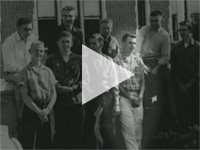 Claunch, T.J., “Dick Cheney’s High School Years.” C-SPAN interview, July 9, 2014. Accessed Oct. 24, 2015 at http://www.c-span.org/video/?320487-1/discussion-former-vice-president-dick-cheneys-high-school-years.
Claunch, T.J., “Dick Cheney’s High School Years.” C-SPAN interview, July 9, 2014. Accessed Oct. 24, 2015 at http://www.c-span.org/video/?320487-1/discussion-former-vice-president-dick-cheneys-high-school-years.
Illustrations
- The photos of Cheney with President Ford and at the Gulf War briefing are from Wikipedia. Used with thanks.
- The photo of Cheney with Thyra Thompson, Alan Simpson, Ronald Reagan and Malcolm Wallop is by longtime Wyoming Tribune-Eagle photographer Fred Yates, from the Alan K. Simpson Collection, American Heritage Center, University of Wyoming. Used with permission and thanks.
- The photo of Cheney and President George W. Bush is from the National Archives. Used with thanks.
